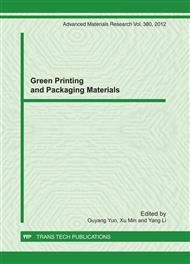p.238
p.244
p.248
p.254
p.260
p.265
p.270
p.274
p.278
Influence of Blow-Up Ratio on Properties of Cellulose Packaging Films by Blow-Extrusion Process
Abstract:
The blow-extruded tube-like regeneration cellulose films in different blow-up ratios were prepared by NMMO technology. It was studied the effect of different blow-up ratio on the mechanical and obstructing properties as well as the morphology cross-section of cellulose blown films. It is found that the tensile strength and obstructing performance except elongation at break of films are improved when blow-up ratios increasing. The tensile strength of 1.3, 1.7 blow-up ratio cellulose blown films in longitudinal and transverse is 36.4MPa and 39.9MPa, 13.8MPa and 29.04MPa, respectively. The elongation at a break of 1.3, 1.7 blow-up ratio cellulose blown films in longitudinal and transverse is 105.4% and 72.01%, 42.4% and 25.79%, respectively. The OPF and WVP value of 1.3, 1.7 blow-up ratio cellulose blown films are 13.34×10-15cm3•cm/(cm2•s•Pa) and 1.36×10-15cm3•cm/(cm2•s•Pa) , 4.18×10-13g•cm/cm2•s•Pa and 1.87×10-13g•cm/cm2•s•Pa, respectively. The SEM picture of cross-section of 1.7 blow-up ratio films displays denser and lower porosity than 1.3 blow-up ratio films. According to the results of study, the films prepared by using NMMO technology would be used in food packaging or other fields as a kind of green packaging material.
Info:
Periodical:
Pages:
260-264
Citation:
Online since:
November 2011
Authors:
Keywords:
Price:
Сopyright:
© 2012 Trans Tech Publications Ltd. All Rights Reserved
Share:
Citation:


